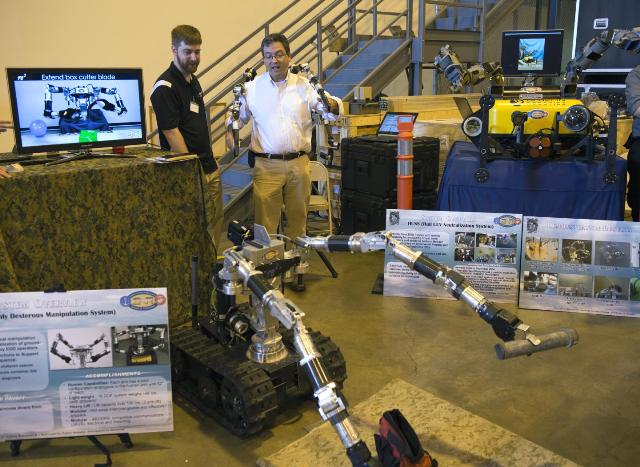Oct 5 2015
Robotic arms help Explosive Ordnance Disposal (EOD) techs to neutralize underwater mines. Autonomous underwater vehicles map out a ship's hull in blackness beneath the water. And hundreds of personnel from six nations come together in one place to work on autonomous underwater vehicles and mine countermeasures (MCM).
 David Rusbarsky, left, a senior scientist with RE2 Robotics, watches as Kevin Gates, a professional staff member with the House Armed Services Committee, tries the Highly Dexterous Manipulation System (HDMS) during the Office of Naval Research-sponsored demonstration of unmanned undersea vehicles at NAS Patuxent River, Md. Credit: (US Navy photo by John F. Williams/Released)
David Rusbarsky, left, a senior scientist with RE2 Robotics, watches as Kevin Gates, a professional staff member with the House Armed Services Committee, tries the Highly Dexterous Manipulation System (HDMS) during the Office of Naval Research-sponsored demonstration of unmanned undersea vehicles at NAS Patuxent River, Md. Credit: (US Navy photo by John F. Williams/Released)
All that and more--including brilliant new images of wooden shipwrecks on a river floor--took place at the Office of Naval Research (ONR)-sponsored Pax River technology demonstrations, which concluded last week at Naval Air Station Patuxent (Pax) River in Maryland.
"This is the cutting edge," said Dr. Walter Jones, executive director at ONR. "These are technologies that will impact the future of naval operations and protect our Sailors and Marines."
While undersea autonomous vehicles aren't on most people's radar, experts say they represent a vital part of the future for American and allied warfighters.
Officials note the technology demonstrations not only advanced the art of the possible when it comes to protecting the future force, but showed the importance of collaboration when it comes to science and technology.
"The MCM program--with vital contributions from partner commands and our international allies--is making great leaps in developing and fielding autonomous, unmanned systems," said Dr. Jason Stack, program officer and lead for ONR's Mine Warfare program. "MCM and EOD represent some of the dull, dirty and truly dangerous jobs performed every day by our Sailors and Marines. These emerging technologies will assist these men and women by making their jobs faster and safer."
A total of 40 unmanned, autonomous or remotely operated systems were demonstrated and tested over the two-week period, including over 30 in the water at one time. Some of those included:
- Unmanned underwater vehicles from Canada, the United Kingdom and the United States worked together with an unmanned surface vehicle from the United Kingdom to search the ocean and seafloor for mines
- Robotic arms built using 3D printing were demonstrated for inspecting and neutralizing underwater explosives attached to ship hulls
- Advanced sensors capable of finding mines buried under the ocean sediment were demonstrated from a variety of platforms--including one capable of movement in any direction using biologically inspired controls and fins.
In addition to the host command of NAS PAX and ONR, partner commands included Naval Air Warfare Center Aircraft Division and Naval Surface Warfare Center Panama City. Uniformed and civilian partner personnel from the United Kingdom, Australia, New Zealand, Canada and Germany were on hand and helped guide much of the efforts.